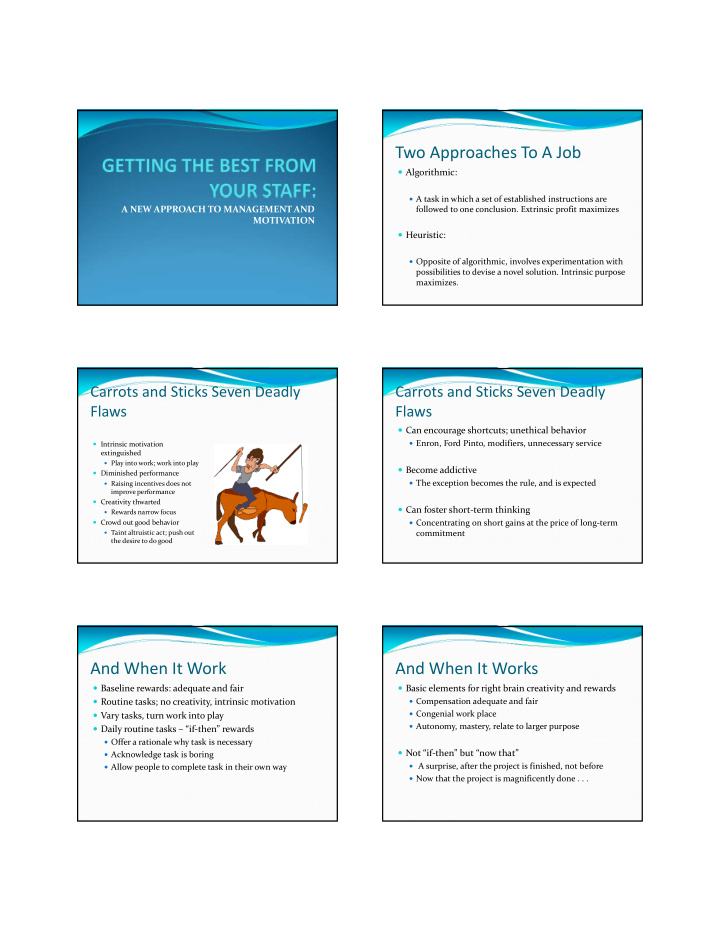



Two Approaches To A Job Algorithmic: A task in which a set of established instructions are A NEW APPROACH TO MANAGEMENT AND followed to one conclusion. Extrinsic profit maximizes MOTIVATION Heuristic: Opposite of algorithmic, involves experimentation with possibilities to devise a novel solution. Intrinsic purpose maximizes. Carrots and Sticks Seven Deadly Carrots and Sticks Seven Deadly Flaws Flaws Can encourage shortcuts; unethical behavior Enron, Ford Pinto, modifiers, unnecessary service Intrinsic motivation extinguished Play into work; work into play Become addictive Diminished performance The exception becomes the rule, and is expected Raising incentives does not improve performance Creativity thwarted Can foster short ‐ term thinking Rewards narrow focus Crowd out good behavior Concentrating on short gains at the price of long ‐ term commitment Taint altruistic act; push out the desire to do good And When It Work And When It Works Baseline rewards: adequate and fair Basic elements for right brain creativity and rewards Routine tasks; no creativity, intrinsic motivation Compensation adequate and fair Congenial work place Vary tasks, turn work into play Autonomy, mastery, relate to larger purpose Daily routine tasks – “if ‐ then” rewards Offer a rationale why task is necessary Not “if ‐ then” but “now that” Acknowledge task is boring A surprise, after the project is finished, not before Allow people to complete task in their own way Now that the project is magnificently done . . .
And When It Works Yes: Can it be No: mastery, Routine? made less autonomy, routine purpose For creative, right brain tasks: No: Use Use rewards; now/that Consider non ‐ tangible rewards; praise and positive even if/then; rewards feedback but Praise & Rational feedback; Provide useful information; praise about effort and Boring Useful strategy rather achieving a particular outcome Own way info. Type I and Type X Type I Traits Almost always outperforms Type X in the long run. Type X: Yesterday’s theory Fueled by extrinsic desires Type I is both born and made. Concerned less with inherent satisfaction Type I does not disdain money or recognition Type I: 21 st Century theory Concerned less with external rewards Type I is a renewable source Inherent satisfaction of the activity itself Need to move from Type X to Type I Type I behavior promotes greater physical and mental well ‐ being Moving from Type X to Type I Autonomy Autonomy Task – FedEx days What they do; When they do it; Who they do it with; How they do it Time – ROWE v. billable hours Mastery A mindset; See abilities as infinitely improvable; Technique – Ritz ‐ Carlton Demands effort, grit and deliberate practice Purpose Team – Building cooperation Goals that use profit to reach purpose; in words that emphasize more than self interest; in policies that allow staff to pursue purpose on their own terms.
Mastery Purpose The desire to get better and better at something that Provides context for mastery and autonomy matters. Compliance v. Engagement Goals Goldilocks Tasks Words: Hippocratic Oath; us/they; why not how Mindset – all in your head Policies: Time to do meaningful activities Painful Purpose goals v. profit goals. Unattainable Type I’s: 13 Ways to Improve Your 13 Ways Continued Hospital or Group Conduct an autonomy audit Time for noncommissioned work: The Big Idea How much autonomy do you have over your tasks? Carve out a small island of noncommissioned work How much autonomy do you have over your time at work? 20 percent time with training wheels How much autonomy do you have over your team at Noncommissioned work Start small, 10%, small group, limited time work? How much autonomy do you have over your technique Turn your next off ‐ site into a FedEx Day at work? One day to work on whatever staff wants Have the proper tools Must deliver something; new idea, better internal process 13 Ways Continued 13 Ways continued Feedback: Peer ‐ to ‐ peer “now that” rewards Annual review flaws: Yearly and rehearsed Self and/or peer performance reviews monthly Avoids flaws of corporate carrot rewards Not as a replacement, but supplement Set both smaller and larger goals Carry a different meaning Relationship to larger purpose Be honest Puts feedback control in the hands of those closest to the activity
13 Ways Continued 13 Ways Continued Take three steps toward giving up control Design for the 85% Involve people in goal ‐ setting Use non ‐ controlling language: must/think about; Workforce policies designed for 15%: Those that need should/consider rigid structures and strict enforcement Hold office hours Play “Whose purpose is it anyway?” Systems design rules to guard against bad behavior actually promotes it In own words “What is our group/department/hospital’s purpose?” Uniform or all over the map Assuming good faith encourages good behavior Is it “we” or “they”? 13 Ways Continued 13 Ways Continued Promote Goldilocks for groups: Not too easy, not too Get agile hard Build projects around motivated people Simplicity Begin with a diverse team Self ‐ organizing teams Group a “No competition zone” Start small and subversive Ask the right question Try task shifting Be strategically subversive Concentrate on purpose, not rewards Emphasize results Paying People the Type I Way Ensure internal and external fairness Pay more than average Make performance metrics wide ‐ ranging, relevant, and hard to game Salespeople: are they different?
Recommend
More recommend